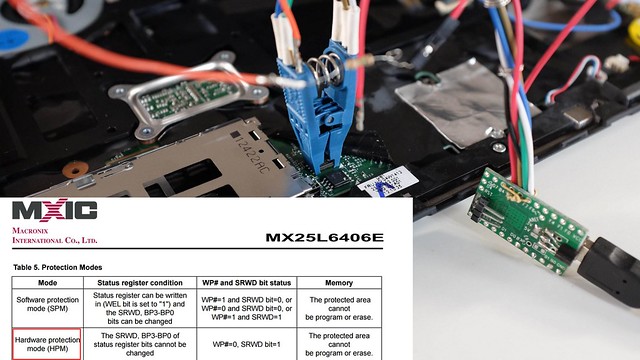mirror of
https://github.com/linuxboot/heads.git
synced 2025-01-19 11:17:06 +00:00
The 8 qemu-* targets all contained nearly-identical copies of the targets to prepare the TPM/disk/etc. and then run Qemu. The only significant differences were for TPM1/TPM2 (extra swtpm_setup step, addition of --tpm2 to swtpm_setup and swtpm). ROOT_DISK_IMG used := or = differently in some boards, := was kept. targets/qemu.mk now defines all Qemu targets and is included only for qemu-* boards (by defining BOARD_TARGETS in each of those boards). The documentation was moved from qemu-coreboot-fbwhiptail-tpm1-hotp/ qemu-coreboot-fbwhiptail-tpm1-htop.md to targets/qemu.md. The other 7 qemu boards' symlinks to that file were removed. Signed-off-by: Jonathon Hall <jonathon.hall@puri.sm>
92 lines
3.9 KiB
Markdown
92 lines
3.9 KiB
Markdown

|
|
|
|
Heads: the other side of TAILS
|
|
===
|
|
|
|
Heads is a configuration for laptops and servers that tries to bring
|
|
more security to commodity hardware. Among its goals are:
|
|
|
|
* Use free software on the boot path
|
|
* Move the root of trust into hardware (or at least the ROM bootblock)
|
|
* Measure and attest to the state of the firmware
|
|
* Measure and verify all filesystems
|
|
|
|

|
|
|
|
NOTE: It is a work in progress and not yet ready for non-technical users.
|
|
If you're interested in contributing, please get in touch.
|
|
Installation requires disassembly of your laptop or server,
|
|
external SPI flash programmers, possible risk of destruction and
|
|
significant frustration.
|
|
|
|
More information is available in [the 33C3 presentation of building "Slightly more secure systems"](https://trmm.net/Heads_33c3).
|
|
|
|
Documentation
|
|
===
|
|
Please refer to [Heads-wiki](https://osresearch.net) for your Heads' documentation needs.
|
|
|
|
|
|
Building heads
|
|
===
|
|
`make BOARD=board_name` where board_name is the name of the board directory under `./boards` directory.
|
|
|
|
In order to build reproducible firmware images, Heads builds a specific
|
|
version of gcc and uses it to compile the Linux kernel and various tools
|
|
that go into the initrd. Unfortunately this means the first step is a
|
|
little slow since it will clone the `musl-cross-make` tree and build gcc...
|
|
|
|
Once that is done, the top level `Makefile` will handle most of the
|
|
remaining details -- it downloads the various packages, verifies the
|
|
hashes, applies Heads specific patches, configures and builds them
|
|
with the cross compiler, and then copies the necessary parts into
|
|
the `initrd` directory.
|
|
|
|
There are still dependencies on the build system's coreutils in
|
|
`/bin` and `/usr/bin/`, but any problems should be detectable if you
|
|
end up with a different hash than the official builds.
|
|
|
|
The various components that are downloaded are in the `./modules`
|
|
directory and include:
|
|
|
|
* [musl-libc](https://www.musl-libc.org/)
|
|
* [busybox](https://busybox.net/)
|
|
* [kexec](https://wiki.archlinux.org/index.php/kexec)
|
|
* [mbedtls](https://tls.mbed.org/)
|
|
* [tpmtotp](https://trmm.net/Tpmtotp)
|
|
* [coreboot](https://www.coreboot.org/)
|
|
* [cryptsetup](https://gitlab.com/cryptsetup/cryptsetup)
|
|
* [lvm2](https://sourceware.org/lvm2/)
|
|
* [gnupg](https://www.gnupg.org/)
|
|
* [Linux kernel](https://kernel.org)
|
|
|
|
We also recommend installing [Qubes OS](https://www.qubes-os.org/),
|
|
although there Heads can `kexec` into any Linux or
|
|
[multiboot](https://www.gnu.org/software/grub/manual/multiboot/multiboot.html)
|
|
kernel.
|
|
|
|
Notes:
|
|
---
|
|
|
|
* Building coreboot's cross compilers can take a while. Luckily this is only done once.
|
|
* Builds are finally reproducible! The [reproduciblebuilds tag](https://github.com/osresearch/heads/issues?q=is%3Aopen+is%3Aissue+milestone%3Areproduciblebuilds) tracks any regressions.
|
|
* Currently only tested in QEMU, the Thinkpad x230, Librem series and the Chell Chromebook.
|
|
** Xen does not work in QEMU. Signing, HOTP, and TOTP do work; see below.
|
|
* Building for the Lenovo X220 requires binary blobs to be placed in the blobs/x220/ folder.
|
|
See the readme.md file in that folder
|
|
* Building for the Librem 13 v2/v3 or Librem 15 v3/v4 requires binary blobs to be placed in
|
|
the blobs/librem_skl folder. See the readme.md file in that folder
|
|
|
|
QEMU:
|
|
---
|
|
|
|
OS booting can be tested in QEMU using a software TPM. HOTP can be tested by forwarding a USB token from the host to the guest.
|
|
|
|
For more information and setup instructions, refer to the [qemu documentation](targets/qemu.md).
|
|
|
|
coreboot console messages
|
|
---
|
|
The coreboot console messages are stored in the CBMEM region
|
|
and can be read by the Linux payload with the `cbmem --console | less`
|
|
command. There is lots of interesting data about the state of the
|
|
system.
|